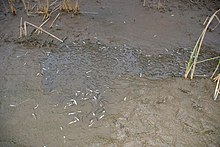Brief Summary
provided by Ecomare
Belica are small fish with large eyes. With their relatively large mouth, they can gobble up eggs and larvae from fish and amphibians, although they eat mostly zooplankton. This fish species normally grows to a maximum of 7 centimeters and is olive green on top and silver underneath. The fish used to be considered a juvenile specimen of some other species. That is why not much is known about where the fish originated.
- license
- cc-by-nc
- copyright
- Copyright Ecomare
Diagnostic Description
provided by Fishbase
Diagnosed from other cyprinids in central and eastern Europe by having incomplete lateral line with about 8-12 pored scales, keel covered by scales between pelvic origin and anus, mouth superior, and 11-13½ branched anal rays (Ref. 59043). A small fish with large silvery scales and an inconspicuous intense silvery band along each side. Lateral line incomplete, sometimes absent, with perforated scales. Anal fin longer than dorsal fin. Mouth turns upwards. The lower edge of the body between the pelvic fins and the vent forms a sharp keel. The scales are very loosely attached and fall away if the fish is handled. Also Ref. 40476.
Life Cycle
provided by Fishbase
Territorial males clean the spawning sites and guard the eggs which are attached in strings around roots, reeds, aquatic vegetation or any material drifting on the water surface (Ref. 59043). When males tend the clutch, which is usually located on the stem of a water plant, they provide the clutch with fresh water by nudging the water plant. In addition, they spread an anti-bacterial fluid over the eggs (Ref. 1672). If possible, some fish will enter streams for spawning.
Migration
provided by Fishbase
Potamodromous. Migrating within streams, migratory in rivers, e.g. Saliminus, Moxostoma, Labeo. Migrations should be cyclical and predictable and cover more than 100 km.
Morphology
provided by Fishbase
Dorsal spines (total): 2 - 3; Dorsal soft rays (total): 7 - 9; Analspines: 3; Analsoft rays: 10 - 13; Vertebrae: 36 - 42
Trophic Strategy
provided by Fishbase
Feeds on plants, phytoplankton, zooplankton, and insects (Ref. 27368).
Biology
provided by Fishbase
Inhabits lowland riverine habitats especially oxbows and other water bodies only connected to rivers during floods. Often encountered in ponds, steppe lakes and small water bodies not connected to rivers (Ref. 59043). Occurs in large schools which are most numerous in autumn. Found between weeds in shallow pools and creeks, shallow lakes, peat and clay excavations and canals. It is exposed to the stormy flow of water (in spring, autumn and winter), but usually choose quite places like small bays, plots behind bottom stones extending out of water and concrete foundations of bridges. In autumn, the schools of fish keep to the surface and rarely go to the pelagic zone. Towards winter, the schools break up and the number of fish per unit of river square decreases rapidly (Ref. 27674); they spend the winter in deeper waters (Ref. 41592). Feeds on phytoplankton and zooplankton and on flying insects (Ref. 27368). Spawns among vegetation (Ref. 30578). Aquarium keeping: at least 10 individuals; minimum aquarium size 100 cm; not recommended for home aquariums (Ref. 51539). Scales were utilized for production of Essence d'Orient, which was used for coating artificial pearls. Locally threatened due to draining of wetlands. Reaches up to about 9 cm SL (Ref. 59043).
Importance
provided by Fishbase
fisheries: of no interest; aquarium: public aquariums
Leucaspius delineatus
provided by wikipedia EN
Leucaspius delineatus, known as the sunbleak, belica or moderlieschen is a species of freshwater fish in the family Cyprinidae. It is currently the only species included in genus Leucaspius, whereas formerly others were included, which now have been moved to Ladigesocypris or Pseudophoxinus or merged with L. delineatus.
Description
The belica is a slender fish with a tapered body which is usually from 4 to 6 cm (1.6 to 2.4 in) long and seldom grows larger than 10 cm (3.9 in). It has an upward-turned mouth and a short lateral line which extends about seven to ten scales from the gill cover. The anal fin is short and consists of eleven to fourteen rays. This is a silvery fish with a particularly intense band of colour running along the flank.[2]
Distribution
The belica is found all over temperate continental Europe and barely extends to Central Asia in the Caucasus region. The southern limits of its range are essentially marked by the Pyrenees and the Alpide belt.
The common name Moderlieschen is of German origin. Although it looks like a proper word that can be approximately translated as "mouldy Lizzy", it is actually a bowdlerized version of an older name which survives in parts of Germany as Mutterloseken. Literally meaning "the little motherless one", this ultimately refers to the fact that the sticky eggs of the moderlieschen can withstand exposure to air for a remarkably long time. Deposited on water plants, they sometimes stick to the feet of ducks and similar birds and are carried by these to ephemeral ponds. Large numbers of young moderlieschens are thus sometimes encountered when such ponds dry up, and with no adult fish being present this gave rise to the belief that they were "motherless".
It has been introduced to Great Britain, and appears to be established in the Avalon Marshes in Somerset and has been implicated in transmitting a new species of parasitic fluke to both European otter and American mink in the area but where it may now be an important prey species for piscivorous birds.[3][4]
See also
References

- license
- cc-by-sa-3.0
- copyright
- Wikipedia authors and editors
Leucaspius delineatus: Brief Summary
provided by wikipedia EN
Leucaspius delineatus, known as the sunbleak, belica or moderlieschen is a species of freshwater fish in the family Cyprinidae. It is currently the only species included in genus Leucaspius, whereas formerly others were included, which now have been moved to Ladigesocypris or Pseudophoxinus or merged with L. delineatus.
- license
- cc-by-sa-3.0
- copyright
- Wikipedia authors and editors


